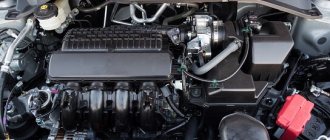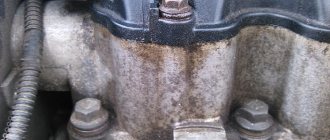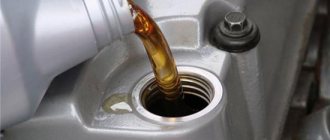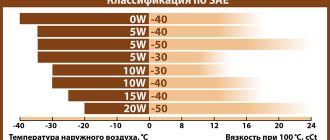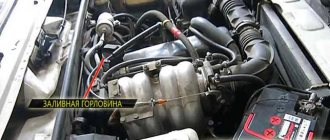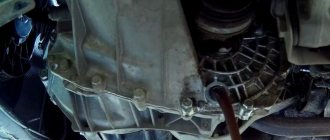Adding motor oil to a car engine is a fairly simple procedure that does not require attention to detail; therefore, any car owner can carry it out independently, while saving on servicing at a car service center.
Some cars have an electronic monitoring system that shows the oil level on the dashboard, but for most vehicles you will still need to reach under the hood and check the oil level with the dipstick. In this article you will learn how to care for your car between maintenance and avoid engine problems.
How to check the oil level in a car engine?
- To take accurate readings, the vehicle must be parked on a level surface. If you have just completed a trip, wait about 5 minutes before proceeding with the check. If you start checking immediately after stopping the car, you risk getting inaccurate readings. Some automakers require that the oil be checked after the engine has warmed up for 2-5 minutes. This requirement is relevant for all cars in winter, when thickened lubricant needs to be restored to fluidity by preheating.
- To avoid unexpected problems, check your oil every month, or more often if you drive long distances.
- Never carry out the test while the engine is running.
- To check the oil level, open the car hood and locate the plastic dipstick handle. If you are not sure where it is located, consult your vehicle's owner's manual. Once you find the dipstick, remove it and wipe it well - you should see 2 marks on the clean dipstick for the maximum and minimum oil levels.
- Insert a clean dipstick and pull it out again. Inspect where the level of the oil mark appears in relation to the levels on the dipstick. If the oil line is in the middle of the minimum and maximum marks, topping up is not required; if below the middle, we recommend adding a little; if it is close to the min level on the dipstick or below it, you must add lubricant.
A brief introduction to the thermodynamics of the lubricant mixing process
The school course on molecular physics examines the question of how homogeneous liquids of different temperatures are mixed. Students are asked to independently derive the formula that determines the final value of heating the mixture:
where T₁ is the temperature of the first component, K;
Т₂ – temperature of the second component, K;
Tav – average temperature of the mixture, T;
m₁ – mass of the first component, kg;
m₂ – mass of the second component, kg.
Conversion of temperature from the Celsius scale to the Kelvin scale is performed using the formula:
The amount of oil to be filled in modern passenger car engines is 3.5...6.5 kg. In a warm engine, its temperature will be 75...90 ⁰С. Approximately 50...70 g of mass is added. The actual temperature of the liquid being added can be negative or positive on the Celsius scale.
Topping up is 5-7% of the mixture weight. Therefore, the temperature effect of the added liquid on the final value will have minimal impact. It should be noted that not only the oil is warmed up, the surrounding engine parts are also quite noticeably warmed up. Therefore, only adiabatic mixing (without environmental influences) will correspond to the calculated formulas.
The actual temperature of the mixture under the specified conditions will be close to the initial value of the heated oil. The added liquid will begin to warm up as it moves along the walls. Once in the pan it will take only a few seconds to warm up.
Attention! When pouring lubricant into an empty pan of a warmed-up car (this often happens at service stations), users note that the liquid warms up quite quickly due to heat exchange with the hot metal of the internal combustion engine structure.
It is customary to distinguish oils based on their carrier base:
- mineral. They are based on thermal oil processing products. Depending on the origin of the fossil, the amount of saturated hydrocarbons (paraffins) present may vary. It is generally accepted that a significant amount of them in the composition may limit the period of use of motor oil based on them;
- synthetic are products of the synthesis of long molecules from gaseous hydrocarbons. A distinctive feature is that the composition of the carrier liquid is a liquid in which one type of fat predominates. They maintain high fluidity over a wide temperature range. The load-bearing capacity of the film is quite high, a layer 40 microns thick can withstand loads of up to 2...4 MPa. Food for thought. Mineral lubricants are usually guaranteed to withstand 0.5-1.5 MPa;
- semi-synthetic oils are created by mechanically mixing mineral and synthetic liquid components. The proportion of mineral components usually does not exceed 30...35% by volume.
Can oils be mixed with each other? Car manufacturers usually remain silent on this issue. At service stations the answer is unequivocal, which is undesirable. In fact, if the situation is such that the lubricant level is below the minimum level, then you can add any engine oil to the crankcase.
Attention! You can only top up with something new and clean. Under no circumstances should work be done.
Objections are possible. Do not mix synthetics and mineral fats. However, it should be remembered that this is the mechanical mixture used in semi-synthetics.
Is it possible to add oil to a hot engine?
Sometimes situations happen when a driver discovers a low oil level on the road, and this is the source of the frequently asked question: “Can I add oil to a hot engine?”
In answering this question, we must note that when adding oil to a hot engine, you will not be able to correctly assess the oil level in the internal combustion engine. If topping up occurs in the summer, the worst that can happen is that you add too much or too little oil. The situation is different with topping up in winter.
In winter, the engine oil in the canister will obviously be quite cold, so pouring cold fluid into a hot engine can cause a temperature difference. It’s one thing when only a small amount of lubricant is added, but another thing when the volume of addition is a liter or more. In the latter case, the result may be unpredictable. Not only will you not be able to correctly estimate the volume of oil required for topping up, but you will also significantly increase the risk of cracks and deformations in the cylinder block, and the appearance of defects on moving and other parts of the internal combustion engine.
Due to the above, we recommend that you do not add engine oil to a hot engine, especially in winter or cold weather. Leave the car for a few minutes, allowing the engine to cool to the optimum temperature.
Motor oils and all necessary auto parts can be purchased at the IXORA store, and professional managers can select the appropriate part.
| Manufacturer | Detail number | Name |
| RAVENOL | 4014835722699 | Engine oil RAVENOL FO SAE 5W-30 (4l) new |
| RAVENOL | 4014835722897 | Motor oil Ravenol Hps SAE New, 5W-30, semi-synthetic, 4L |
| RAVENOL | 4014835722958 | Motor oil Ravenol Hcl SAE New, 5W-30, synthetic, 5L |
| RAVENOL | 4014835723054 | Motor oil Ravenol Hls SAE New, 5W-30, synthetic, 5L |
| RAVENOL | 4014835722590 | Motor oil Ravenol Super Fuel Economy sfe SAE New, 5W-20, synthetic, 4L |
| RAVENOL | 4014835723511 | Engine oil Ravenol vsi SAE New, 5W-40, synthetic, 1L |
| RAVENOL | 4014835723993 | Motor oil Ravenol Hcs SAE New, 5W-40, synthetic, 4L |
| SHELL | 550040295 | Motor oil Shell Helix HX8, 5W-40 SN Plus, 4L |
| SHELL | 550040424 | Motor oil Shell Helix HX8, 5W-40 SN Plus, 1L |
| SHELL | 550040312 | Motor oil Shell Helix HX7, 10W-40 SN Plus, 1L |
| SHELL | 550040428 | Motor oil Shell Helix HX7 Diesel, 10W-40, 4L |
| SHELL | 550040315 | Motor oil Shell Helix HX7, 10W-40 SN Plus, 4L |
| SHELL | 550040462 | Motor oil Shell Helix HX8, 5W-30, 1L |
| SHELL | 550040558 | Motor oil Shell Helix Ultra Diesel, 5W-40, 4L |
| CASTROL | 153BE1 | Motor oil Castrol Edge Titanium FST, 5W-40, synthetic, 4L |
| CASTROL | 156EDD | Motor oil Castrol Magnatec Diesel, 5W-40, synthetic, 4l |
| CASTROL | 156ED8 | Motor oil Castrol Magnatec Diesel, 10W-40, semi-synthetic, 4L |
| CASTROL | 15667C | Motor oil Castrol Edge SAE Synthetic EU, 5W-30, synthetic, 1L |
| CASTROL | 15669A | Motor oil Castrol Edge SAE Synthetic EU, 5W-30, synthetic, 4L |
| CASTROL | 156CAF | Magnatec Stop-Start E 5W20 oil |
* Please check the applicability of parts specifically for your car with our managers by phone (calls within Russia are free).
What to do if you don’t have the right oil at hand
There are situations when there is no supply of lubricant, and you need to top it up urgently. Drivers use any available oil: a product of a different brand, of different viscosity and even purpose. In a critical situation, this is allowed, for example, to travel to a car service center or to the nearest garage for service. It is advisable to maintain the type of base: add mineral oil to mineral oil and synthetic to synthetic. There will be minimal risk when topping up with material from the same manufacturer. When driving with this oil, try not to overload the engine. As soon as possible, change the fluid along with the filter.
In other situations, you cannot mix different materials. Active additives can interact chemically. Sediment and carbon deposits form in the engine, and oxidative processes accelerate. You will have to completely drain the fluid, flush the engine and fill in new oil.
Lubrication System - Brief Overview
One of the most important parts of a car engine is the mechanism for lubricating it - the so-called lubrication system. This system is able to effectively protect all internal elements of the machine from wear. To ensure stable and trouble-free operation of the entire engine lubrication mechanism over a long period of time, I advise you to carefully monitor its technological condition throughout all years of operation. Also try to fill it with new lubricant on time or change it to clean one.
In this article, I tried to tell you how you can independently control the amount of oil in the engine lubrication system, and also wrote about the consequences of neglecting this. What can happen if you increase or decrease the amount of lubricant in the lubrication system, I also tried to clearly explain how to correctly change the lubricant in a car engine.
So, let's start by checking the condition and amount of lubricant in the system. Some car owners of recently purchased cars do not understand at all and are not even aware of the consequences of incorrect actions when changing the lubricant. They don’t know how to properly fill the engine with lubricant when driving their car after purchasing it to the first service station.
But why spend money on maintaining your car if you can do everything yourself? At the same time, relying on the warranty from the manufacturer, they quickly forget the main tenets of car maintenance and cease to understand the basic principles of filling oil. They also do not take into account the fact that in the machine operating book all the basic tips for maintaining machine elements are clearly indicated.
By the way, it’s worth checking the lubricant level in the engine from time to time (this must be done once every 12-15 days), especially during long trips.
What does excess or lack of automotive lubricant lead to?
Any experienced driver will tell you that the oil level with a warm engine should be at the mark between the lower and upper bars of the mechanical dipstick. How to measure the amount of motor oil?
Is it possible to add oil to a hot engine? The answer is that it is not advisable, since the level readings will be incorrect, and you can get burned during the procedure. It is recommended to check the level “cold”, after a night of inactivity, or through an express check, which consists of the following. First, you need to warm up the engine power plant to optimal operating condition. A short trip is an excellent way to warm up the engine. After this, the vehicle should be secured on a flat surface, turn off the engine and wait about 20-30 minutes. This is necessary so that the oil mass flows into the oil pan. Next, the lubricant level is measured.
Excess oil
Before adding oil to the engine, it is necessary to take into account the main mistakes that novice drivers make. Most beginners believe that you can pour oil as much as you like or you always need to maintain the level at the maximum level of the oil rod, the effect will only be better.
The first consequence is poor engine crankability. This is explained by the fact that any motor fluid has a certain viscosity, and its excess amount in the system creates additional resistance. Working parts spend more energy moving. This results in increased fuel consumption, but this is not the worst thing.
During operation, the lubricant begins to expand in the vehicle’s engine system. In a high-temperature environment, increased pressure occurs, which has a negative effect on all seals of the operating device. All seals and gaskets begin to squeeze out over time, and engine oil leaks. Crankshaft oil seals are especially sensitive, since the lubricant is supplied under pressure. As a result, the entire interior of the engine becomes dirty, and the seals must be replaced. In addition, there are a number of other consequences of overfilling: it is difficult to start the car in cold weather, “sticking” of piston rings, foaming of the oil composition.
Lack of consumable oil
Lack of lubricant also has a detrimental effect on the vehicle’s power plant. The effect of oil starvation of working units and mechanisms appears, that is, at the moment the engine starts, oil flows to the moving parts in insufficient quantities. A small volume of lubricant is not able to form a strong film to reduce contact between metal surfaces.
The crankshaft will begin to operate without lubricant, resulting in the formation of fine metal dust, which will subsequently enter the engine fluid. Over time, there is a high probability of piston jamming.
It is for these reasons that it is necessary to regularly check the lubricant level and add it if necessary.
Using quality lubricants
- The use of proven motor lubricants can significantly increase the operating time of a car engine. Also, branded lubricants support the machine’s engine at the most optimal level in all key indicators.
- For standard gasoline engines, I would recommend Shell 5W20 series lubricants, which can be replaced quite easily and which practically do not become dirty during operation.
At its core, this automobile oil is perfect for the operation of engines of almost all cars. It is used in all-wheel drive cars of Mercedes and other brands, and can also be poured into cars of domestic brands. The lubricant can be used in manual transmissions and internal transfer cases, but only if the manufacturer has specified the use of the 5w90 class.
Sources
- https://gil-service.ru/ts/mozhno-li-zalivat-maslo.html
- https://CARHack.ru/kak-sdelat-zamenu-masla-v-goryachem-dvigatele/
- https://TrueScooters.ru/tehservis/kak-dolit-maslo.html
- https://KrutiMotor.ru/kogda-nuzhno-i-kak-pravilno-dolivat-motornoe-maslo/
- https://trevojnui.ru/mozhno-li-zalivat-maslo-v-goryachiy-dvigatel-letom/
- https://atlant-rabota.ru/ts-i-remont/kak-pravilno-dolit-maslo-v-dvigatel.html
- https://ixora-auto.ru/Info/mojno_li_dolivat_maslo_v_goryachijj_dvigatel_
- https://izst-detail.ru/mozhno-li-dolivat-maslo-v-goryachiy-dvigatel/
[collapse]
